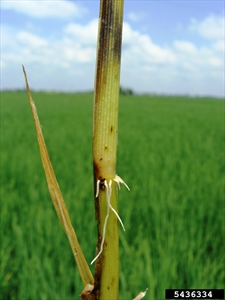Bakanae disease of rice; also known as Fool’s rice, foot rot. Bakanae is from the Japanese for 'foolish seedling'. On maize it is known as maize Fusarium kernel rot (see Fact Sheet no. 224).
Pacific Pests, Pathogens, Weeds & Pesticides - Online edition
Pacific Pests, Pathogens, Weeds & Pesticides
Rice bakanae disease (429)
Gibberella fujikuroi. The asexual state is Fusarium moniliforme. Fusarium fujikuroi is the name given on Species Fungorum, synomymous with Fusarium moniliforme (https://www.speciesfungorum.org/GSD/GSDspecies.asp?RecordID=314213).
Africa, Asia, North, South, and Central America, the Caribbean, Europe, Oceania. It is recorded from Australia, America Samoa, Fiji, Guam, New Caledonia, New Zealand, Papua New Guinea, Solomon Islands, and Vanuatu. Note, there are differences between authorities. For instance, bakanae (Gibberella fujikuroi) is an exotic plant pest not present in Australia. The list above is from CABI. (see references under (see Acknowledgements).
Rice, and many other crops, including: banana, cotton, cowpea, fig, maize, sorghum, sugarcane, and tomato. Although there are many hosts, those of most economic importance are in the Poaceae, the grass family, which includes maize, rice, sorghum and millet. Grass weeds are also hosts.
The disease is caused by a fungus that is seed and soilborne. Infected seed results in poor seedling emergence, and gaps in the rows. Surviving seedlings are yellow, thin, taller than usual with fewer tillers, and may wilt and die. Those that reach maturity become very tall due to abnormal elongation of internodes, and do not form filled grain (Photos 1&2). On these plants, pink-white fungal growth occurs at soil level, and moves up the stems. The nodes on infected plants may be pink to purple beneath the leaf sheaths, and lower nodes may produce roots (Photo 3). Root rot occurs from soilborne infections.
Contamination of grain occurs at flowering by airborne spores – asexual ‘conidia’ and sexual ‘ascospores’ - formed on the tillers (stems and leaf sheaths). Infected seed produces elongated, bakanae, seedlings after planting. Soil infestations lead to root rot. From the roots, the fungus travels up the tillers, producing spores, which spread to the new grain and to the soil. Spores are also produced in large numbers on the straw and stubble and contaminate the panicles at harvest.
Bakanae infection is favoured by dryland cultivation and high temperatures (>30°C). Lower temperatures and very dry soil favours root rot.
Spread occurs via spores carried on the wind or in water. Long-distance spread is on and in infected seed. The fungus remains viable in seed or about 1-2 years, and for about 1 year in the soil. Seedborne levels of up to 25% are recorded by IRRI.
IRRI reports crop losses of up to 20% in outbreaks of bakanae in South and Southeast Asia [e.g., losses reported in Japan (20-50%), India (4%), and Thailand (15%)]. Graham states: "The disease is the most serious seed and soilborne disease of dryland rice in Fiji, particularly in the Rewa Valley of Viti Levu"1.
Look for abnormally tall thin yellowish-green plants in the nursery and field. Look for white fungal growth at the base and lower parts of tillers. Strip away the leaf sheaths and look for pink to purple nodes on the stems. Look for roots at the nodes. Standard seed health protocols exists for this disease.
CULTURAL CONTROL
Before planting:
- Rotate rice after 2 years with non-susceptible crops, such as vegetables or root crops.
- Use certified seed, free from contamination and infection. If unsure, use a seed dressing (see below).
During growth:
-
Pull out infected plants as soon as they are seen.
After harvest:
- Burn straw and stubble, or plough into soil as soon as soon as possible after harvest.
CHEMICAL CONTROL
Treat seed with thiram or thiram combined with thiophanate-methyl to eradicate spores on the surface of seeds. Fungicides in the azole and strobilurin groups are also effective. Trials using bleach (sodium hypochlorite) have reduced the incidence of the disease.
____________________
When using a pesticide, always wear protective clothing and follow the instructions on the product label, such as dosage, timing of application, and pre-harvest interval. Recommendations will vary with the crop and system of cultivation. Expert advice on the most appropriate pesticide to use should always be sought from local agricultural authorities.
AUTHOR Grahame Jackson
Information (and Photo 2) from Bakanae. Rice Knowledge Bank. IRRI. (http://www.knowledgebank.irri.org/training/fact-sheets/pest-management/diseases/item/bakanae); and CABI (2021) Gibberella fujikuroi (bakanae disease of rice). Crop Protection Compendium. (https://www.cabi.org/cpc/datasheet/25158); and Bakanae. Department of Primary Industries, NSW Government, Australia. (https://www.dpi.nsw.gov.au/biosecurity/plant/insect-pests-and-plant-diseases/Bakanae); and Bakanae disease rice – India: (Uttar Pradesh) (2021). ProMED, Archive number: 20210825.8620058. (https://promedmail.org/promed-posts/); and from Graham KM (1971) Plant diseases of Fiji. Her Majesty's Stationery Office. London. Photo 1&3 O.P. Sharma, NCIPM, New Delhi. India, Bugwood.org).
Produced with support from the Australian Centre for International Agricultural Research under project HORT/2016/185: Responding to emerging pest and disease threats to horticulture in the Pacific islands, implemented by the University of Queensland and the Secretariat of the Pacific Community.






